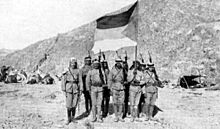
Faisal I bin al-Hussein bin Ali al-Hashemi was King of Iraq from 23 August 1921 until his death in 1933. A member of the Hashemite family, he was a leader of the Great Arab Revolt during the First World War, and ruled as the unrecognized King of the Arab Kingdom of Syria from March to July 1920 when he was expelled by the French.
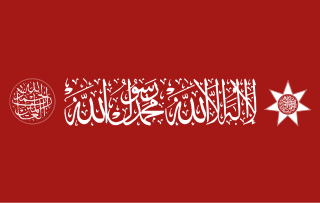
The Hashemites, also House of Hashim, are the royal family of Jordan, which they have ruled since 1921, and were the royal family of the kingdoms of Hejaz (1916–1925), Syria (1920), and Iraq (1921–1958). The family had ruled the city of Mecca continuously from the 10th century, frequently as vassals of outside powers, and ruled the thrones of the Hejaz, Syria, Iraq, and Jordan following their World War I alliance with the British Empire.

The flag of Iraq consists of the three equal horizontal red, white, and black stripes of the Arab Liberation flag, with the takbir written in green in the Kufic script in the centre.

The national flag of Saudi Arabia is a green background with Arabic inscription and a sword in white. The inscription is the Islamic creed, or shahada: "There is no deity but God; Muhammad is the Messenger of God". The current design has been used by the government of Saudi Arabia since 15 March 1973.
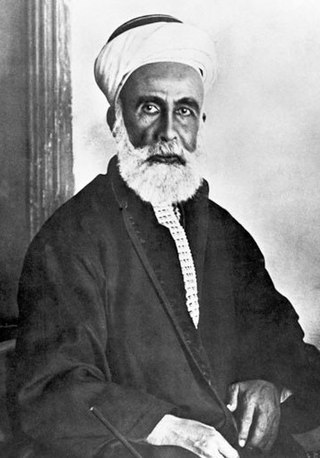
Hussein bin Ali al-Hashimi was an Arab leader from the Banu Qatadah branch of the Banu Hashim clan who was the Sharif and Emir of Mecca from 1908 and, after proclaiming the Great Arab Revolt against the Ottoman Empire, King of the Hejaz, even if he refused this title, from 1916 to 1924. He proclaimed himself Caliph after the abolition of the Ottoman Caliphate in 1924 and stayed in power until 1925 when Hejaz was invaded by the Saudis. His Caliphate was opposed by the British and French empires, the Zionists and the Wahhabis alike. However, he received support from a large part of the Muslim population of that time and from Mehmed VI. He is usually considered as the father of modern pan-Arabism.
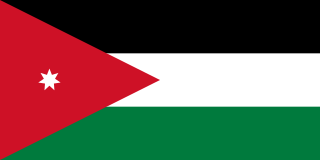
The flag of Jordan, officially adopted on 16 April 1928, is based on the 1916 flag of the Arab Revolt against the Ottoman Empire during World War I. The flag consists of horizontal black, white, and green bands that are connected by a red chevron. The colours are the Pan-Arab Colors, respectively representing the Abbasid, Umayyad, and Fatimid or Rashidun caliphates. The red chevron is for the Hashemite dynasty, and the Arab Revolt.

The Arab Revolt, also known as the Great Arab Revolt, was an armed uprising by the Hashemite-led Arabs of the Hejaz against the Ottoman Empire amidst the Middle Eastern theatre of World War I.
As a result of the Syrian Civil War since 2011, there are at least two flags used to represent Syria, used by different factions in the war. The incumbent government of the Syrian Arab Republic led by the Ba'ath Party uses the red-white-black tricolour originally used by the United Arab Republic, while Syrian opposition factions such as the Syrian National Coalition use the green-white-black tricolour known as the ''Independence flag'', first used by Mandatory Syria.
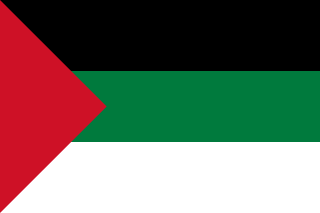
The pan-Arab colors are black, white, green and red. Individually, each of the four pan-Arab colors were intended to represent a certain aspect of the Arab people and their history.

The Hashemite Kingdom of Hejaz was a state in the Hejaz region of Western Asia that included the western portion of the Arabian Peninsula that was ruled by the Hashemite dynasty. It was self-proclaimed as a kingdom in June 1916 during the First World War, to be independent from the Ottoman Empire, on the basis of an alliance with the British Empire to drive the Ottoman Army from the Arabian Peninsula during the Arab Revolt.
An Islamic flag is the flag either representing an Islamic Caliphate, religious order, state, civil society, military force or other entity associated with Islam. Islamic flags have a distinct history due to the Islamic prescription on aniconism, making particular colours, inscriptions or symbols such as crescent-and-star popular choices. Since the time of the Islamic prophet Muhammad, flags with certain colours were associated with Islam according to the traditions. Since then, historical Caliphates, modern nation states, certain denominations as well as religious movements have adopted flags to symbolize their Islamic identity. Some secular states and ethnic or national movements also use symbols of Islamic origin as markers of heritage and identity.
The Damascus Protocol was a document given to Faisal bin Hussein on 23 May 1915 by the Arab secret societies al-Fatat and al-'Ahd on his second visit to Damascus during a mission to consult Turkish officials in Constantinople.
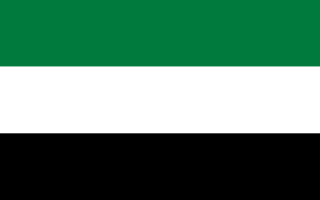
Al-Fatat or the Young Arab Society was an underground Arab nationalist organization in the Ottoman Empire. Its aims were to gain independence and unify various Arab territories that were then under Ottoman rule. It found adherents in areas such as Syria. The organization maintained contacts with the reform movement in the Ottoman Empire and included many radicals and revolutionaries, such as Abd al-Mirzai. They were closely linked to the Al-Ahd, or Covenant Society, who had members in positions within the military, most were quickly dismissed after Enver Pasha gained control in Turkey. This organization's parallel in activism were the Young Turks, who had a similar agenda that pertained to Turkish nationalism.

The Arab Kingdom of Syria was a self-proclaimed, unrecognized monarchy existing briefly in the territory of historical Syria. It was announced on October 5,1918 as a fully independent Arab constitutional government with the permission of the British military. It gained independence as an Emirate after the withdrawal of the British forces from OETA East on 26 November 1919, and was proclaimed as a Kingdom on 8 March 1920.

The Sharifian Empire was a Empire proclaimed by the Sharifian leaders of the Hejaz in 1924, replacing the Ottoman Caliphate, which was abolished by Mustafa Kemal Atatürk. Even though the Banu Hashim held the caliphate at various points in history, Hussein bin Ali, the Sharif of Mecca, was the first and last caliph of this lineage.

The Sharifate of Mecca or Emirate of Mecca was a state, non-sovereign for much of its existence, ruled by the Sharif of Mecca. A sharif is a descendant of Hasan ibn Ali, Muhammad's grandson. In Western sources, the prince of Mecca was known as Grand Sherif, but Arabs have always used the appellation "Emir".
National symbols of Jordan are the symbols that are used in Jordan and abroad to represent the country and its people.
This is a timeline of major events in the history of the modern state of Jordan.
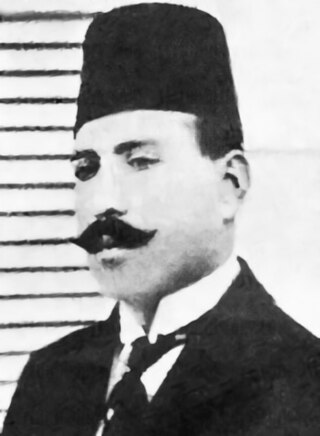
Nasib al-Bakri was a Syrian politician and nationalist leader in the first half of the 20th century. He played a major role in establishing al-Fatat, an underground organization which sought the independence and unity of the Ottoman Empire's Arab territories. As the chief envoy between al-Fatat and the Hejaz-based Hashemites, al-Bakri became a close aide to Emir Faisal when the latter became King of Syria following the success of the 1916 Arab Revolt. Al-Bakri opposed the establishment of the French Mandate of Syria and became one of the chief commanders of the Great Syrian Revolt, leading the rebels' brief capture of Damascus. He escaped a death warrant in Syria in 1927, but returned the following year after being amnestied.


